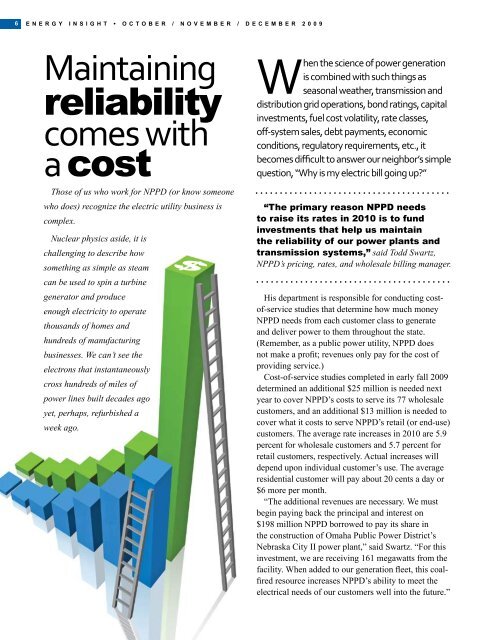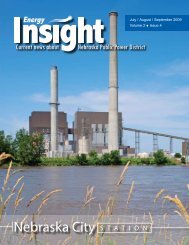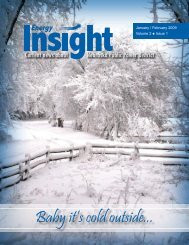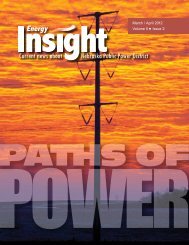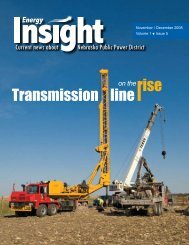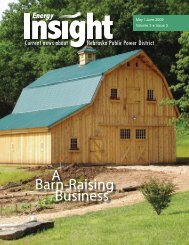Oct. / Nov. / Dec. 2009 - Nebraska Public Power District
Oct. / Nov. / Dec. 2009 - Nebraska Public Power District
Oct. / Nov. / Dec. 2009 - Nebraska Public Power District
You also want an ePaper? Increase the reach of your titles
YUMPU automatically turns print PDFs into web optimized ePapers that Google loves.
6<br />
ENERGY INSIGHT • OCTOBER / NOVEMBER / DECEMBER <strong>2009</strong><br />
Maintaining<br />
reliability<br />
comes with<br />
a cost<br />
Those of us who work for NPPD (or know someone<br />
who does) recognize the electric utility business is<br />
complex.<br />
Nuclear physics aside, it is<br />
challenging to describe how<br />
something as simple as steam<br />
can be used to spin a turbine<br />
generator and produce<br />
enough electricity to operate<br />
thousands of homes and<br />
hundreds of manufacturing<br />
businesses. We can’t see the<br />
electrons that instantaneously<br />
cross hundreds of miles of<br />
power lines built decades ago<br />
yet, perhaps, refurbished a<br />
week ago.<br />
When the science of power generation<br />
is combined with such things as<br />
seasonal weather, transmission and<br />
distribution grid operations, bond ratings, capital<br />
investments, fuel cost volatility, rate classes,<br />
off-system sales, debt payments, economic<br />
conditions, regulatory requirements, etc., it<br />
becomes difficult to answer our neighbor’s simple<br />
question, “Why is my electric bill going up?”<br />
“The primary reason NPPD needs<br />
to raise its rates in 2010 is to fund<br />
investments that help us maintain<br />
the reliability of our power plants and<br />
transmission systems,” said Todd Swartz,<br />
NPPD’s pricing, rates, and wholesale billing manager.<br />
His department is responsible for conducting costof-service<br />
studies that determine how much money<br />
NPPD needs from each customer class to generate<br />
and deliver power to them throughout the state.<br />
(Remember, as a public power utility, NPPD does<br />
not make a profit; revenues only pay for the cost of<br />
providing service.)<br />
Cost-of-service studies completed in early fall <strong>2009</strong><br />
determined an additional $25 million is needed next<br />
year to cover NPPD’s costs to serve its 77 wholesale<br />
customers, and an additional $13 million is needed to<br />
cover what it costs to serve NPPD’s retail (or end-use)<br />
customers. The average rate increases in 2010 are 5.9<br />
percent for wholesale customers and 5.7 percent for<br />
retail customers, respectively. Actual increases will<br />
depend upon individual customer’s use. The average<br />
residential customer will pay about 20 cents a day or<br />
$6 more per month.<br />
“The additional revenues are necessary. We must<br />
begin paying back the principal and interest on<br />
$198 million NPPD borrowed to pay its share in<br />
the construction of Omaha <strong>Public</strong> <strong>Power</strong> <strong>District</strong>’s<br />
<strong>Nebraska</strong> City II power plant,” said Swartz. “For this<br />
investment, we are receiving 161 megawatts from the<br />
facility. When added to our generation fleet, this coalfired<br />
resource increases NPPD’s ability to meet the<br />
electrical needs of our customers well into the future.”


